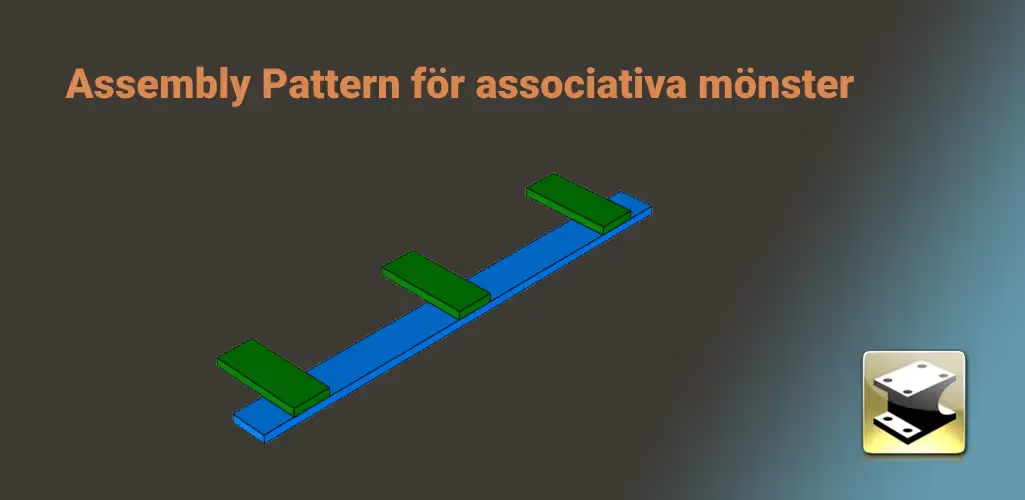Download Centre

Looks like you don't have ESC button on your device
Download IronCAD DCS
Choose one of the following options
trial versionHas a license

Emil Rindell

Jonas Bryntesson

Henrik Andersson
2025-04-29

Emil Rindell

Jonas Bryntesson

Henrik Andersson
2025-04-29
The Assembly Pattern tool allows you to create patterns of parts and assemblies that are associative with other geometry. In the past we have had to use the parameter table and associate parameters to TriBall patterns.
Footnote. The Assembly Pattern feature was introduced with v2024 and not with v2025 as stated at the beginning of the video.
Assembly Pattern i IRONCAD is a powerful tool that allows you to duplicate components or groups of components in a structured and precise way. This is particularly useful when working with repeated elements in designs, such as screws, struts, frames or modular parts.
Assembly Pattern allows you to create linear patterns, where the components are placed in straight rows or columns. This is ideal for repeated parts of a structure, such as mounting plates or beams. You can easily adjust the spacing, number and direction of components to suit your design.
For designs containing rotating parts or circular arrangements, you can use circular patterns. Ideal for wheels, gears or star formations, where each component must be placed at a precise angle. This saves time and ensures precision.
One of the main advantages of Assembly Pattern is the possibility to change parameters afterwards. If you need to adjust the spacing between components or the number of repetitions, this can be done without recreating the entire assembly. This provides a much more flexible workflow and reduces the risk of errors.
By using Assembly Pattern you can:
Assembly Pattern makes design faster, more accurate and easier to maintain, making it an invaluable tool for all IRONCAD.
Answer: Here we publish tips, guides, news and solutions for those who work with IRONCAD and Design Data Manager (DDM). The blog covers everything from basic functions to advanced workflows, helping you to optimize your design work. You'll find examples of smart shortcuts, practical instructions, solutions to common problems, and best practices for product design, mechanical design, and product data management.
Answer: Our guides and tips are designed for both beginners and experienced CAD users. They are aimed at designers, engineers and project managers who want to work more efficiently with IRONCAD and DDM, improve the design process, reduce mistakes and save time in product development.
Answer: We regularly publish new articles when the software is updated, when new features are introduced, or when our users ask for solutions to specific problems. The blog is therefore a reliable source for keeping up to date and getting tips that make everyday CAD work easier.
Answer: Many of our instructions and tips work in multiple versions, but we clearly indicate if an article applies to a specific version. We strive to make the content useful for older versions as well, and also provide recommendations on how to adapt workflows to the version you are using.
Answer: Absolutely! If you can't find the solution in the blog, you can contact our technical support via solidmakarna.support. Our experts will help you with everything from installation and configuration to advanced features in IRONCAD and DDM, so you can solve problems quickly and efficiently.
Answer: Yes! We appreciate suggestions from our users. If you have questions, tips or want us to address a specific issue in IRONCAD or DDM , please contact us via our contact form and we will prioritize relevant topics in future posts.
Answer: The blog contains, among other things:
Practical step-by-step guides to help you use IRONCAD and DDM more effectively.
Productivity and workflow tips for faster design and construction.
Solutions to common problems encountered by users in CAD programs.
Updates and news on new features, versions and improvements.
Best practices for data management and project organization in DDM.
Answer: All tips and guides are directly applicable in daily work. For example, you can use shortcuts and smart features in IRONCAD to speed up modeling, structure files better in Design Data Manager, or follow our step-by-step solutions for specific problems that often come up in design projects.
Answer: We strive to ensure that all guides and tips are relevant to the latest versions of IRONCAD and DDM. We also clearly mark when a post applies to an older version, so you always know if the instruction is directly applicable to your system.
Answer: Yes! Many of our users share the articles with colleagues and use them as internal training materials. The blog is a great complement to formal training and helps teams learn features faster, avoid mistakes, and standardize workflows in IRONCAD and DDM.